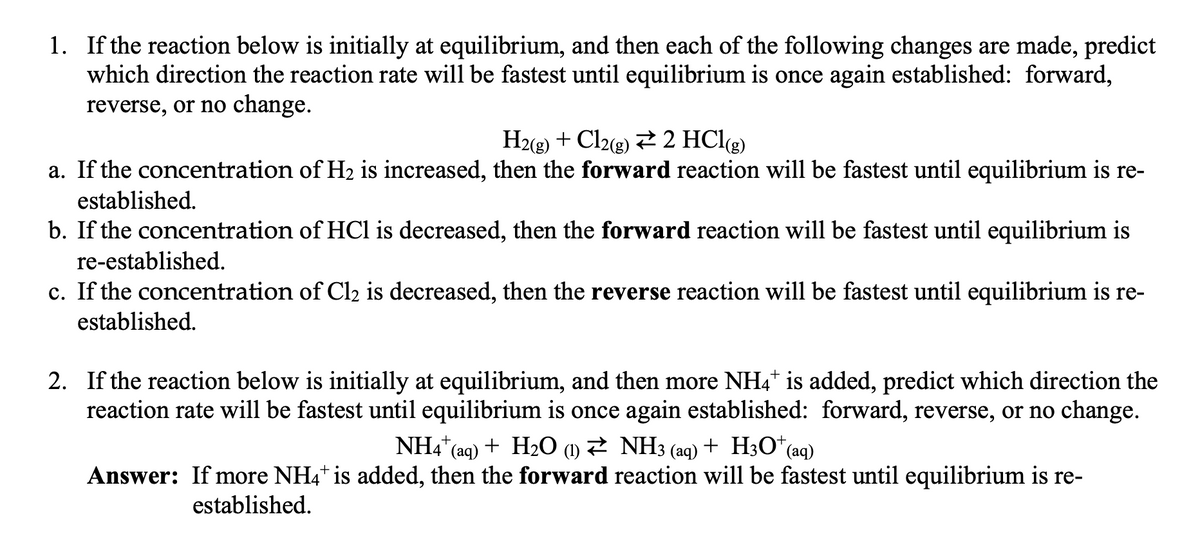1. If the reaction below is initially at equilibrium, and then each of the following changes are made, predict which direction the reaction rate will be fastest until equilibrium is once again established: forward, reverse, or no change. H2(g) + Cl2(g) + 2 HCl(g) a. If the concentration of H₂ is increased, then the forward reaction will be fastest until equilibrium is re- established. b. If the concentration of HCl is decreased, then the forward reaction will be fastest until equilibrium is re-established. c. If the concentration of Cl₂ is decreased, then the reverse reaction will be fastest until equilibrium is re- established. 2. If the reaction below is initially at equilibrium, and then more NH4* is added, predict which direction the reaction rate will be fastest until equilibrium is once again established: forward, reverse, or no change. NH4+ (aq) + H₂O (1) ⇒ NH3 (aq) + H3O+ (aq) Answer: If more NH4* is added, then the forward reaction will be fastest until equilibrium is re- established.
1. If the reaction below is initially at equilibrium, and then each of the following changes are made, predict which direction the reaction rate will be fastest until equilibrium is once again established: forward, reverse, or no change. H2(g) + Cl2(g) + 2 HCl(g) a. If the concentration of H₂ is increased, then the forward reaction will be fastest until equilibrium is re- established. b. If the concentration of HCl is decreased, then the forward reaction will be fastest until equilibrium is re-established. c. If the concentration of Cl₂ is decreased, then the reverse reaction will be fastest until equilibrium is re- established. 2. If the reaction below is initially at equilibrium, and then more NH4* is added, predict which direction the reaction rate will be fastest until equilibrium is once again established: forward, reverse, or no change. NH4+ (aq) + H₂O (1) ⇒ NH3 (aq) + H3O+ (aq) Answer: If more NH4* is added, then the forward reaction will be fastest until equilibrium is re- established.
Introductory Chemistry: A Foundation
9th Edition
ISBN:9781337399425
Author:Steven S. Zumdahl, Donald J. DeCoste
Publisher:Steven S. Zumdahl, Donald J. DeCoste
Chapter17: Equilibrium
Section: Chapter Questions
Problem 1ALQ: Consider an equilibrium mixture of four chemicals (A. B. C. and D. all gases) reacting in a closed...
Related questions
Question
100%
I need help with this questions and show the work step by step?

Transcribed Image Text:1. If the reaction below is initially at equilibrium, and then each of the following changes are made, predict
which direction the reaction rate will be fastest until equilibrium is once again established: forward,
reverse, or no change.
H2(g) + Cl2(g) + 2 HCl(g)
a. If the concentration of H₂ is increased, then the forward reaction will be fastest until equilibrium is re-
established.
b. If the concentration of HCl is decreased, then the forward reaction will be fastest until equilibrium is
re-established.
c. If the concentration of Cl₂ is decreased, then the reverse reaction will be fastest until equilibrium is re-
established.
2. If the reaction below is initially at equilibrium, and then more NH4* is added, predict which direction the
reaction rate will be fastest until equilibrium is once again established: forward, reverse, or no change.
NH4+ (aq) + H₂O (1) ≥ NH3 (aq) + H3O+ (aq)
Answer: If more NH4+ is added, then the forward reaction will be fastest until equilibrium is re-
established.
Expert Solution
This question has been solved!
Explore an expertly crafted, step-by-step solution for a thorough understanding of key concepts.
This is a popular solution!
Trending now
This is a popular solution!
Step by step
Solved in 4 steps

Knowledge Booster
Learn more about
Need a deep-dive on the concept behind this application? Look no further. Learn more about this topic, chemistry and related others by exploring similar questions and additional content below.Recommended textbooks for you

Introductory Chemistry: A Foundation
Chemistry
ISBN:
9781337399425
Author:
Steven S. Zumdahl, Donald J. DeCoste
Publisher:
Cengage Learning


Chemistry: An Atoms First Approach
Chemistry
ISBN:
9781305079243
Author:
Steven S. Zumdahl, Susan A. Zumdahl
Publisher:
Cengage Learning

Introductory Chemistry: A Foundation
Chemistry
ISBN:
9781337399425
Author:
Steven S. Zumdahl, Donald J. DeCoste
Publisher:
Cengage Learning


Chemistry: An Atoms First Approach
Chemistry
ISBN:
9781305079243
Author:
Steven S. Zumdahl, Susan A. Zumdahl
Publisher:
Cengage Learning

Chemistry
Chemistry
ISBN:
9781305957404
Author:
Steven S. Zumdahl, Susan A. Zumdahl, Donald J. DeCoste
Publisher:
Cengage Learning

Chemistry for Engineering Students
Chemistry
ISBN:
9781285199023
Author:
Lawrence S. Brown, Tom Holme
Publisher:
Cengage Learning

Chemistry for Today: General, Organic, and Bioche…
Chemistry
ISBN:
9781305960060
Author:
Spencer L. Seager, Michael R. Slabaugh, Maren S. Hansen
Publisher:
Cengage Learning